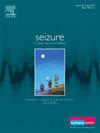杏仁核体积不对称提示颞叶癫痫的侧性:MRI-SEEG研究
IF 2.7
3区 医学
Q2 CLINICAL NEUROLOGY
引用次数: 0
摘要
目的正常人的杏仁核体积是左右不对称的。不对称杏仁核增生在颞叶癫痫(TLE)中有描述,但其侧侧意义尚不清楚。在这项对TLE患者进行立体脑电图(SEEG)的研究中,我们检查了杏仁核体积(AV)不对称的侧化价值,以及它与癫痫发作时杏仁核受累的关系。方法将30例无影像学海马硬化症的TLE患者行SEEG检查时的杏仁核体积与标准数据库的数据进行比较。我们设计了一种新的杏仁核(体积)不对称指数(AAI),将AAI与seeg确定的TLE偏侧和癫痫发作中的杏仁核受累联系起来。结果在组水平上,右TLE右侧AVs (RTLE)和左TLE左侧AVs (LTLE)均显著高于对照组(右差:平均226 mm3;左差:平均206mm3)。AAI显著高于RTLE组和双颞叶癫痫组(16/17例;平均AAI差异8.4%),且显著低于LTLE组(8/9例;平均AAI差- 8.3%)。癫痫发作时杏仁核受累与绝对AAI呈正相关(Spearman ρ = 0.45, p <;0.05)。结论左室左右不对称的明显偏离在TLE中几乎是普遍存在的,并且具有很强的侧化价值。相对阳性的AAI与RTLE或双颞叶癫痫有关;相对负的AAI与LTLE相关。较大的AAI偏差与较高比例的癫痫发作与杏仁核受累有关,提示癫痫发作对TLE中杏仁核扩张有因果影响。本文章由计算机程序翻译,如有差异,请以英文原文为准。
Amygdalar volume asymmetry informs laterality in temporal lobe epilepsy: MRI-SEEG study
Objective
Amygdalar volumes are right-left asymmetric in normal humans. Asymmetric amygdalar hyperplasia is described in temporal lobe epilepsy (TLE), but has unclear lateralizing significance. In this study of TLE patients undergoing stereo-electroencephalography (SEEG) we examined the lateralizing value of amygdalar volume (AV) asymmetry, and its relationship to amygdalar involvement in seizures.
Methods
Amygdalar volumes of 30 TLE patients without radiological hippocampal sclerosis undergoing SEEG were compared to those from a normative database. Devising a novel amygdalar (volume) asymmetry index (AAI), we correlated AAI to SEEG-ascertained TLE lateralization and amygdalar involvement in seizures.
Results
At the group level, right AVs in right TLE (RTLE) and left AVs in left TLE (LTLE) were significantly higher than in controls (right difference: mean 226 mm3; left difference: mean 206 mm3). AAI was significantly higher than in RTLE and bitemporal epilepsy than in controls (16/17 patients; mean AAI difference 8.4 %) and significantly lower than in LTLE than in controls (8/9 patients; mean AAI difference -8.3 %). Amygdalar involvement in seizures correlated positively with absolute AAI (Spearman's ρ = 0.45, p < 0.05).
Conclusions
Significant deviation from physiological right-left AV asymmetry is almost universal in TLE and has robust lateralizing value. Relatively positive AAI is associated with RTLE or bitemporal epilepsy; relatively negative AAI is associated with LTLE. Larger AAI deviations are associated with a higher proportion of seizures with amygdalar involvement, suggesting a causal influence of seizures on amygdalar expansion in TLE.
求助全文
通过发布文献求助,成功后即可免费获取论文全文。
去求助
来源期刊

Seizure-European Journal of Epilepsy
医学-临床神经学
CiteScore
5.60
自引率
6.70%
发文量
231
审稿时长
34 days
期刊介绍:
Seizure - European Journal of Epilepsy is an international journal owned by Epilepsy Action (the largest member led epilepsy organisation in the UK). It provides a forum for papers on all topics related to epilepsy and seizure disorders.
 求助内容:
求助内容: 应助结果提醒方式:
应助结果提醒方式:


